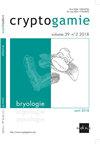格拉齐奥历史收藏中的苔藓植物:重新审视里约热内卢的植物区系及其保护意义
IF 0.9
3区 生物学
Q4 PLANT SCIENCES
引用次数: 1
摘要
1858年,奥古斯特·格拉齐奥应巴西皇帝佩德罗二世的邀请前往巴西,在里约热内卢市担任皇家公园和花园的主任,直到1897年。他被认为是巴西最伟大的植物收藏家之一,收集了大量的苔藓植物。巴西里约热内卢州的苔藓菌群是巴西最丰富的苔藓菌群之一,但也包括了数量最多的濒危物种。Glaziou在巴西的里约热内卢进行了收集,那里的大西洋森林覆盖率大大减少,生物多样性丧失。本工作的目的是分析Glaziou登记的物种,评估当时取样的苔藓菌群百分比,重新收集和评估该物种的保护状况。结果表明,86%的Glaziou收集的物种是在巴西里约热内卢州收集的,4%是在过去60年收集的,10%是在过去100年未发现的,2种仅在原始Glaziou收集(=类型)中已知。我们的实地调查记录了35%的物种在其原址。巴西里约热内卢州共有18种濒危物种,其中16种为严重濒危物种(CR), 2种为濒危物种(EN), 3种不受关注物种(LC)和1种数据不足物种(DD)。本文章由计算机程序翻译,如有差异,请以英文原文为准。
Bryophytes from Glaziou's Historical Collections: Revisiting the Flora of Rio de Janeiro and Implications for Conservation
ABSTRACT Auguste Glaziou went to Brazil in 1858 at the invitation of Emperor D. Pedro II where he worked as director of the Imperial House of Parks and Gardens in the city of Rio de Janeiro until 1897. He is considered one of the greatest plant collectors of Brazil and collected numerous bryophytes. The bryoflora of the state of Rio de Janeiro is one of the richest in the country, but also includes the highest number of threatened species. Glaziou collected in Rio de Janeiro where the coverage of the Atlantic Forest suffered a great reduction and loss of biodiversity. The objectives of this work are to analyze the species registered by Glaziou, assess what percentage of the bryoflora was sampled at that time, re-collect and evaluate the conservation status of the species. Our results show that 86% of the species collected by Glaziou have been collected in the state Rio de Janeiro. 4% percent have been collected in the last 60 years, 10% has not been found in the last 100 years and two species remain only known from the original Glaziou collection (= type). Our fieldwork recorded 35% of the species in their original sites. Eighteen species are considered threatened taxa in the state of Rio de Janeiro, including 16 species that are critically threatened (CR), two threatened (EN), three of little concern (LC) and one of insufficient data (DD).
求助全文
通过发布文献求助,成功后即可免费获取论文全文。
去求助
来源期刊

Cryptogamie Bryologie
生物-植物科学
CiteScore
2.10
自引率
25.00%
发文量
12
审稿时长
3 months
期刊介绍:
Cryptogamie is a fully electronic journal, with a continuous
publication stream, devoted to a wide diversity of cryptogamic
topics, mainly in the taxonomic-phylogenetic field.
Cryptogamie, Bryologie accepts articles on systematics as
well as ecology and evolution of all of bryophytes.
Thematic issues may also be published under the responsibility of a guest editor.
 求助内容:
求助内容: 应助结果提醒方式:
应助结果提醒方式:


